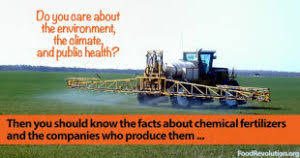30
Mar
Chemical-Intensive Farms Singled Out for Excessive Use of “New” Nitrogen Fertilizers
 (Beyond Pesticides, March 30, 2018) While conventional farming practices rely primarily on new sources of synthetic nitrogen fertilizer to grow crops, organic agriculture conserves nitrogen by using recycled sources, as detailed by new research published by the University of Virginia (UVA) and The Organic Center. Of concern is ‘reactive nitrogen,’ which is nitrogen in a form that will eventually be used by plants (ex. nitrous oxide (N2O), nitrate (NO3–), nitrite (NO2–), ammonia (NH3), and ammonium (NH4+)), rather than benign, non-reactive nitrogen in the form of N2. “This research is significant and timely because its findings show that many common organic farming practices—like composting and the use of manure fertilization in place of synthetic fertilizers—can recycle reactive nitrogen that is already in the global system rather than introducing new reactive nitrogen into the environment, and thus have a much smaller environmental impact,” said Jessica Shade, PhD of The Organic Center.
(Beyond Pesticides, March 30, 2018) While conventional farming practices rely primarily on new sources of synthetic nitrogen fertilizer to grow crops, organic agriculture conserves nitrogen by using recycled sources, as detailed by new research published by the University of Virginia (UVA) and The Organic Center. Of concern is ‘reactive nitrogen,’ which is nitrogen in a form that will eventually be used by plants (ex. nitrous oxide (N2O), nitrate (NO3–), nitrite (NO2–), ammonia (NH3), and ammonium (NH4+)), rather than benign, non-reactive nitrogen in the form of N2. “This research is significant and timely because its findings show that many common organic farming practices—like composting and the use of manure fertilization in place of synthetic fertilizers—can recycle reactive nitrogen that is already in the global system rather than introducing new reactive nitrogen into the environment, and thus have a much smaller environmental impact,” said Jessica Shade, PhD of The Organic Center.
Earlier this year, researchers at the University of California Davis published a study in Science Advances with the finding that regulators in the state drastically underestimate chemical-intensive agriculture’s contribution to nitrogen oxide (NOx) caused air pollution, acid rain, and respiratory illness in the state. While NOx pollution is usually associated with energy production and vehicle emissions, fertilizer use on crop fields is contributing to significant air pollution problems. Advocates have said that the study is an urgent call for farmers to eliminate dependency on soluble, synthetic, nitrogen-based fertilizers and adopt the use of insoluble soil amendments that support soil biology that provide plants with nutrients.
Nitrogen fertilizer is associated with a range of human health and environmental problems. Much of the fertilizer that is not taken up by plants is either released into the atmosphere in its reactive form, where it can cause air pollution, or makes its way into waterways, where it can result in toxic algae blooms. In 2016, Florida’s lake Okeechobee, the largest in the state, experienced an algae bloom that resulted in the Governor declaring an environmental state of emergency. In 2014, a bloom of toxic cyanobacteria, a blue-green algae, contaminated lake Erie so significantly that it resulted in a “do not drink, do not boil” water crisis in the City of Toledo, Ohio. According to a report published in February 2018, regulators are likely drastically underestimating the amount that nitrogen gasses released from fertilized fields contribute to air pollution.
The health risks of nitrogen pollution are greater than “blue-baby syndrome.” A 2016 found that nitrate that made its way into drinking water was associated with birth defects, cancers, and thyroid problems.
The Organic Center, UVA study found that 60 to 100 percent of inputs on conventional farms came from new sources of reactive nitrogen fertilizer. This is synthetic fertilizer, created by an industrial process known as Haber-Bosch, wherein benign nitrogen from the air is converted into ammonia. This form of nitrogen is immediately available to plants.
On the other hand, organic farms were found to utilize nitrogen primarily from recycled sources, such as compost and manure. This accounts for between 80 and 95 percent of nitrogen used in organic agriculture, with the only new nitrogen formed being that which is produced by nitrogen-fixing bacteria on the roots of legumes and cover crops. Overall, researchers found that organic practices resulted in 64% less new nitrogen into the environment.
The Organic Center’s Tracy Misiewicz, PhD notes, “The total number of nitrogen atoms on Earth remains constant, so we need to understand what proportion of the total is present in a polluting form vs. a non-polluting form. This research shows that rather than converting benign nitrogen into polluting nitrogen, organic farming practices overwhelmingly recycle reactive nitrogen instead of introducing new reactive nitrogen into our environment.”
Moreover, the recycled sources of nitrogen used on organic farms usually require microbial action in order to convert nitrogen into a plant available form. This ensures that nitrogen added to these fields stays in place longer, rather than running off into local waterways or emitting polluted forms into the atmosphere.
These data mean that 93% of conventional food consumed comes from newly created nitrogen sources, while only 33% of organic nitrogen came from new sources.
Organic systems never employ the use of synthetic nitrogen fertilizers produced via the Haber-Bosch process. Synthetic fertilizers are prohibited under the Organic Foods Production Act, the statute that establishes organic certification and the USDA organic food label. Concerned consumers can help support an environmentally stable, less polluted food production system by purchasing organic food whenever possible. Individuals can also get involved by passing policies that stop the use of synthetic inputs in their community, and eliminate the use of synthetic fertilizers on their own property by referring to Beyond Pesticides’ List of Organic Compatible Fertilizer Products. Follow the lead of communities like Dover, NH, which recently restricted both synthetic pesticide and fertilizer inputs. Contact Beyond Pesticides at [email protected] or 202-543-5450, for resources to create change.
All unattributed positions and opinions in this piece are those of Beyond Pesticides.
Source: The Organic Center










